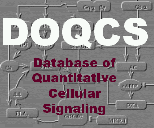
|
Enter a Search String | | Special character and space not allowed in the query term.
Search string should be at least 2 characters long. |
Molecule Parameter List for neurogranin_PSD | The statistics table lists the distribution of a molecule acting either as a substrate, product, enzyme or as a molecule within the network.
The text color of a molecule is highlighted by  color. color. | | Statistics |
Accession and Pathway Details | |
| Accession Name | Accession No. | Accession Type | Pathway Link | AMPAR_CaMKII_
weak_coupling | 65 | Network |
Shared_Object_AMPAR_CaMKII_weak_coupling, CaMKII, CaM,
PP1, PP2B, PP1_PSD,
AMPAR, PKA, AC,
AMPAR_memb, PP1_CaMKII_PSD, CaMKII_PSD | | This is a model of weak coupling between the AMPAR traffikcing bistability, and the CaMKII autophosphorylation bistability. In this model, there are three stable states: Both off, AMPAR on, or both on. The fourth possible state: CaMKII on but AMPAR off, is not truly stable, since over the course of hours the AMPAR also turns on. |
neurogranin_PSD acting as a Molecule in AMPAR_CaMKII_weak_coupling Network
| Name | Accession Name | Pathway Name | Initial Conc.
(uM) | Volume
(fL) | Buffered | | neurogranin_PSD | AMPAR_CaMKII_
weak_coupling
Accession No. : 65 | CaM
Pathway No. : 283 | 10 | 0.01 | No | | Also known as RC3 and p17 and BICKS. Conc in brain >> 2 uM from Martzen and Slemmon J neurosci 64 92-100 1995 but others say less without any #s. Conc in dend spines is much higher than overall, so it could be anywhere from 2 uM to 50. We will estimate 10 uM as a starting point. Gerendasy et al JBC 269:35 22420-22426 1994 have a skeleton model (no numbers) indicating CaM-Ca(n) binding .... |
neurogranin_PSD acting as a Substrate for an Enzyme in AMPAR_CaMKII_weak_coupling Network
neurogranin_PSD acting as a Product of an Enzyme in AMPAR_CaMKII_weak_coupling Network
Enzyme Molecule /
Enzyme Activity | Accession Name | Pathway Name | Km (uM) | kcat (s^-1) | Ratio | Enzyme Type | Reagents | CaM_Ca_n-CaNAB /
dephosph_
neurogranin_PSD
| AMPAR_CaMKII_
weak_coupling
Accession No. : 65 | PP2B
Pathway No. : 285 | 10.012 | 0.67 | 3.98507 | explicit E-S complex | Substrate
neurogranin*_
PSD
Product
neurogranin_PSD
| | From Seki et al ABB 316(2):673-679 |
neurogranin_PSD acting as a Substrate in a reaction in AMPAR_CaMKII_weak_coupling Network
| Kd is calculated only for second order reactions, like nA+nB <->nC or nA<->nC+nD, where n is number and A,B,C,D are molecules, where as for first order reactions Keq is calculated.
Kd for higher order reaction are not consider. |
| Name | Accession Name | Pathway Name | Kf | Kb | Kd | tau | Reagents |
neurogranin-bind
-CaM_
PSD | AMPAR_CaMKII_
weak_coupling
Accession No. : 65 | CaM
Pathway No. : 283 | 0.3
(uM^-1 s^-1) | 1
(s^-1) | Kd(bf) = 3.3333(uM) | - | Substrate
CaM-PSD
neurogranin_PSD
Product
neurogranin-CaM_
PSD
| | Surprisingly, no direct info on rates from neurogranin at this time. These rates are based on GAP-43 binding studies. As GAP-43 and neurogranin share near identity in the CaM/PKC binding regions, and also similarity in phosph and dephosph rates, I am borrowing GAP-43 kinetic info. See Alexander et al JBC 262:13 6108-6113 1987 |
neurogranin_PSD acting as a Product in a reaction in AMPAR_CaMKII_weak_coupling Network
| Kd is calculated only for second order reactions, like nA+nB <->nC or nA<->nC+nD, where n is number and A,B,C,D are molecules, where as for first order reactions Keq is calculated.
Kd for higher order reaction are not consider. |
| Name | Accession Name | Pathway Name | Kf | Kb | Kd | tau | Reagents |
dephosph-neurogr
anin_
PSD | AMPAR_CaMKII_
weak_coupling
Accession No. : 65 | CaM
Pathway No. : 283 | 0.005
(s^-1) | 0
(s^-1) | - | - | Substrate
neurogranin*_
PSD
Product
neurogranin_PSD
| | This is put in to keep the basal levels of neurogranin* experimentally reasonable. From various papers, specially Ramakers et al JBC 270:23 1995 13892-13898, it looks like the basal level of phosph is between 20 and 40%. I est around 25 % The kf of 0.005 gives around this level at basal PKC activity levels of 0.1 uM active PKC. |
| Database compilation and code copyright (C) 2022, Upinder S. Bhalla and NCBS/TIFR
This Copyright is applied to ensure that the contents of this database remain freely available. Please see FAQ for details. |
|
